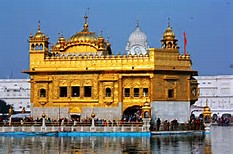
- Dr Satish K Kapoor
Sri Harimandir Sahib,the sacred Sikh shrine in Amritsar(Punjab), called also Darbar Sahib or the Golden Temple, reflects the glory of the Infinite, making one bask in His resplendence. It resounds with the Melody Transcendent pulling the human soul upwards towards the Supreme source of existence, and eliminates in the process, fetters of lower propensities. The spiritual vibrations which pervade the shrine make one relaxed and peaceful. Believed to be a part of the providential plan, Sri Harimandir Sahib was given a visual shape by Guru Arjun Dev(1563-1606) in supernal moments with a view to fulfilling man’s quest for Truth, Beauty and Bliss.
Sri Guru Granth Sahib,the priceless pearl in the sanctum sanctorum fills one’s heart with the divine light and dispels the mist of ignorance. It drenches the seeker in the love of god, deepens one’s understanding of Him and makes one worthy recipient of His grace. It presents a unique philosophy of life and a set of egalitarian values which can form the praxis of a new world order. It strengthens faith in the Supreme and beacons one to tread the path of virtue.
Shreyamkam, a Sanskrit composition (CE 1801) by Krishan Kaur Mishra, describes the Harimandir as a blossoming lotus in the pool of nectar. It says that the sacred place was raised by the workers of Shri Ram Das,fourth Sikh Guru, for the purification of their own self and for pilgrimage.The devotees include all sections of society including women, hunas, andhras, pulinda, Jhivar, nata and low castes. Under the spell of bhakti which endows one with mystical power (siddhi), the devotees sing the glory of God, savour the vedantic, upanishadic and puranic lore, and recite the hymns of Nanak with fervour.
Various traditions ascribe holiness to Harimandir by linking it to a pool of nectar (amrit kund) in ancient times, the performance of an important yajna (sacrifice) by the Suryavanshi King, Ikshavaku, and the sojourns of Gautama the Buddha, and of Padamasambhava – an 8th century Buddhist scholar . Guru Nanak Dev (1469-1539) visited the place in early 16th century. It is believed that the chronic skin disease of Guru Angad Dev (1504-1552), second Sikh guru, was cured by a herb which was found near the kund. Another popular story is that of a leper who was completely cured after taking bath in the pond, much to the astonishment of his wife Rajni,daughter of Rai Duni Chand, a revenue collector of Patti. Akbar (1542-1605), the great Mughal Emperor, offered a jagir to Guru Amar Das(1479-1574),third Sikh guru, for the maintenance of langar – free kitchen- which the latter politely declined. The emperor, then, sanctioned that jagir to his daughter, Bibi Bhani (1535-1598).
Although the excavation of sacred pool ( ) was begun by Guru Ram Das(1534-1581), fourth Sikh Sikh guru, it was left to his successor, Guru Arjun Dev to make it wider, deeper, and pucca with bricks. After its completion, Guru Arjun Dev constructed a shrine in the middle of sarovar with the help of devoted Sikhs like Bhai Buddha(1506-1631), Bhai Gurdas (1551-1636), Bhai Salho (d.1628), Bhai Bhagtu, Bhai Bahlo (Bahilo Sidhu; 1553-1643), Bhai Kalyana and many more. When Hazrat Mian Mir (1550-1635), Sufi sant of the Qadrite Order, was invited to lay its foundation stone, it set the first example in communal amity in medieval times.
The land for raising the religious centre was either donated by the philanthropists of village Sultanwind or purchased by the Guru himself from the zamindars of Tung village. The entire area gradually came to be known as Chak Guru Ram Das or Ramdaspura, now Amritsar(Punjab).
When told that the shrine ought to be higher than other buildings in the neighborhood, Guru Arjun Dev replied : ‘No, what is humble, shall be exalted.’ He built up a flight of ten steps to lead down to the temple, and constructed four doorways in four different directions to show that it was open to all and closed to none.
After the completion of Harimandir, ‘temple of god’, Guru Arjan Dev observed : ditthe sabh thav nahee tudh jeha – ‘I have been to many places, but none can match thy grandeur.’ (SGGS, p.1362).He thanked the Almighty for having given him the strength to concretize his cherished dream and spoke rapturously of the divine virtues of the sacred sarovar.
O saints, beauteous is the tank of Ram Das;
Yea whosoever bathes in it, his whole progeny is blest.
He is acclaimed by the whole World,
And all the desires of his mind are fulfilled.
Bathing, his mind is in peace,
For he contemplates God, his Lord.
He who bathes in this tank of the saints
Receiveth the Supreme Bliss.
He dieth not, nor cometh, nor goeth;
(for) he dwelleth only upon the Lord’s Name.
He alone knoweth this wisdom of the Lord
Whom the Lord blesseth with mercy.
Nanak seeks the refuge of God, the Lord,
And all his woes and cares are past.
– Sri Guru Granth Sahib, p.623
Shreyamkam, echoes Guru Arjun Dev’s sentiments by saying that just a glimpse of the sacred tank can destroy one’s sins of previous births; its touch can make the human mind pure and serene, and a holy bath in it can give one salvation. Even those who merely contemplate on it can find their desires fulfilled. (1.8).
The Adi Granth,first compilation of Sri Guru Granth Sahib, was installed in the Harimandir in 1604 and Bhai Buddha was appointed as its first head priest. The Granth is a unique compilation of the hymns of Sikh gurus, sants, bhaktas, bhattas(bards) and sufi faqirs, belonging to different communities. To give a few examples: Jaideva of Bengal was a brahmin , Sheikh Farid of Pak Pattan was a Sufi mystic, Kabir of Banaras was a weaver, Namadeva of Maharashtra was a Shimpi(tailor)of Varkari tradition,Trilochan of Maharashtra was a Vaishya, Sain of Madhya Pradesh was a barber,Dhanna of Rajasthan was a jat peasant , Ravidas of Uttar Pradesh was a Charmakar-leather-worker- and the Sikh gurus were Punjabi Khatris. The Adi Granth is a work of religious synthesis, born of the spiritual experiences of realized souls . Set in 31 different raagas or musical patterns, and compiled in the Gurmukhi script,the hymns lead one from spiritual darkness to the glory of the Supreme Being, reminding everyone in the process about the unity of God and the brotherhood of man. Guru Hargobind (1595-1644),sixth Sikh Guru, who wielded the swords of miri and piri, constructed the Akal Takht,’throne of the immortal’ in front of Harimandir to conduct his temporal affairs. Since then, Akal Takht, stands as a living symbol of the spiritual and mundane aspects of life.
TO BE CONTINUED NEXT WEEK
———————————————————————–
Dr Satish K Kapoor, a former British Council Scholar, was Principal, Lyallpur Khalsa College,Jalandhar and Registrar,DAV University, Jalandhar( Punjab).


 South Asian News E-Paper
South Asian News E-Paper Punjabi News E-Paper
Punjabi News E-Paper

















